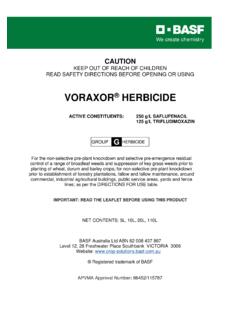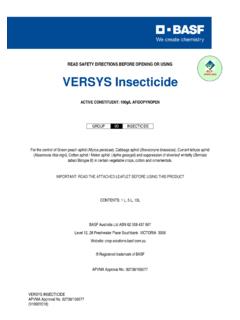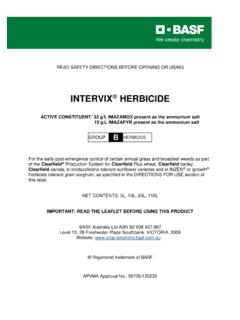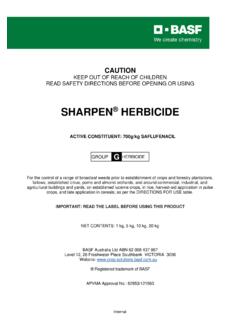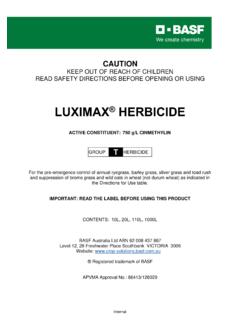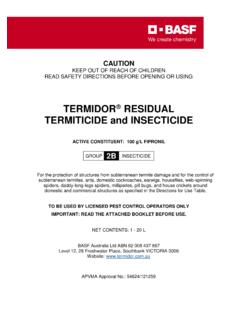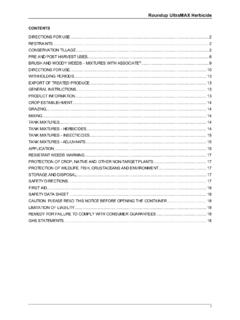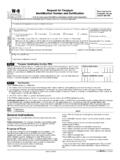Transcription of Basta
1 CAUTION keep OUT OF reach OF children read safety directions before opening OR USING Basta NON-SELECTIVE HERBICIDE ACTIVE CONSTITUENT: 200 g/L GLUFOSINATE-AMMONIUM GROUP N HERBICIDE For non-residual control of broadleaf and grass weeds in various situations as specified in the directions FOR USE table. IMPORTANT: read THE LEAFLET before USING THIS PRODUCT CONTENTS: 1 55 L, 60 L, 100-150 L, 1000 L BASF Australia Ltd ABN 62 008 437 867 Level 12, 28 Freshwater Place Southbank VICTORIA 3006 Website: Registered trademark of BASF APVMA Approval No.: 39118/120934 directions FOR USE RESTRAINTS DO NOT apply with aircraft.
2 DO NOT apply when rain is expected within 6 hours. DO NOT apply to weeds under stress due to, for example, very dry, very wet, frosty or diseased conditions. SUGARCANE DO NOT apply in areas where slope exceeds 4%. A. PLANTATIONS, VINEYARDS and OTHER ROW CROPS CROP/ SITUATION WEEDS STATE RATE WHP CRITICAL COMMENTS Blackberry, boysenberry, loganberry, raspberry Primocane and sucker control NSW, ACT, Vic, Tas only 500 mL /100 L water Nil (H) 8 weeks (G) Apply as a directed spray to suckers and primocanes. Contact with flowers, developing fruit or desirable foliage will cause damage. Ensure complete coverage of primocanes/suckers by spraying to the point of runoff, preferably when they are less than 15 cm high.
3 A non-ionic wetting agent (1000 g/L) may be added at a rate of 25 mL/100 L or equivalent. Tropical and sub-tropical fruits inedible peel, including, Avocado, banana, feijoa, guava, kiwifruit, litchi, mango, pawpaw, passionfruit, pineapple, pitaya (dragon fruit), rambutan plantations See list of weeds controlled in Table 1. All States to L/ha Apply as a directed or shielded spray. Refer to the label section Application for specific information on application methods. Warnings: Do not allow spray or spray drift to contact desirable foliage or green (uncalloused) bark.
4 To avoid potential crop damage, refer to the label sections on Application and PROTECTION OF CROPS, NATIVE AND OTHER NON-TARGET PLANTS. Controlled Droplet Application equipment must not be used for application in cherry orchards. Basta may be used around trees/vines less than two years old provided they are effectively shielded from spray and spray drift. The recommended rate of use is determined by the following criteria: WEED SPECIES WEED STAGE OF GROWTH WEED DENSITY CLIMATIC CONDITIONS WEED SPECIES Apply the appropriate rate to control the least susceptible weed present as per the lists of weeds controlled in the accompanying tables.
5 Citrus orchards Olive plantations CROP/ SITUATION WEEDS STATE RATE WHP CRITICAL COMMENTS Pome and stone fruit orchards See list of weeds controlled in Table 1. All States to L/ha 21 days (H) 8 weeks (G) WEED STAGE OF GROWTH Use the lower rate when weeds are young and succulent (grasses: pre-tillering; broadleaves: cotyledons to 4-leaf) or the population is very sparse. A median rate should be used for medium sized plants (grasses: tillering; broadleaves: 4 leaf to advanced vegetative) and the high rate should be used when weeds are mature (grasses: noding to flowering; broadleaves: budding to flowering).
6 WEED DENSITY Use the higher rates when the weed population is dense. Thorough coverage of weeds is essential for good control. CLIMATIC CONDITIONS Best results are achieved when applied under warm humid conditions (temperatures below 33 C with a relative humidity above 50 %). Control will be reduced and/or slower under cold conditions. Good results will be achieved under most other conditions, however poor results may occur under hot, dry conditions. Weeds that have been hardened or stunted in growth due to stressed conditions should be treated at the maximum rate. COVERAGE Complete coverage of weeds is essential for good control.
7 Poor coverage may result in re-growth. PERENNIAL WEEDS Apply when weeds are actively growing. Follow up treatments will be necessary to control re-growth of perennial weeds in most cases. Tree nut plantations Nil (H) 8 weeks (G) Vineyards Strawberries, cane berry fruits (inter-row) Apply as a directed or shielded spray to the inter-row area. Take care not to allow spray or spray drift to contact the crop, including strawberry runners. Refer to GENERAL INSTRUCTIONS for warnings concerning plastic mulch and fumigated/sterilised soil. Determine the recommended rate of use by considering the criteria WEED SPECIES, WEED STAGE OF GROWTH, WEED DENSITY and CLIMATIC CONDITIONS, as described above.
8 Tomatoes (inter-row) Blueberries Take care not to allow spray or spray drift to contact the crop. DO NOT apply to young, green or un-calloused and damaged blueberry plants. DO NOT apply to weeds under stress. DO NOT apply in unfavourable weather conditions. Blackcurrant Take care not to allow spray or spray drift to contact the crop, including foliage, flowers, fruits or young stems. DO NOT make more than 2 applications per season. Green Bean / French Bean (Field use only) 4 weeks (H) 4 weeks (G) Use inter-row shielded sprayer with a fan nozzle delivering coarse droplets. Use lower rates when weeds are young or the population is sparse, and higher rates when weeds are mature or weed population is dense.
9 Apply to actively growing weeds. Do not apply more than 1 application per season. Pyrethrum Spear thistle, cleavers, hawkbit, cats ear, dandelion plus any weeds listed in Table 1 30 to 75 mL/15 L water 8 weeks (G) Apply directly to weeds by knapsack direct contact with pyrethrum. CROP/ SITUATION WEEDS STATE RATE WHP CRITICAL COMMENTS Duboisia See list of weeds controlled in Table 1. All States to L/ha 8 weeks (G) Spray should be directed to the base of the plants avoiding contact with the foliage. Best results are achieved when applied under warm humid conditions.
10 Complete coverage of weeds is essential for good control. Date Palms (Phoenix dactylifera) 1 day (H) 8 weeks (G) DO NOT allow spray, including drift, to contact any part of the crop as severe damage or crop destruction may result. It is recommended to use shielded sprayer or hooded spray nozzles when spraying between crop rows or near the emerged crops to avoid crop damage from direct spray and drift. Apply as necessary to actively growing weeds, free from environmental stresses, up to a maximum three (3) applications per season. Rotate herbicide mode of action groups within and across growing seasons.
